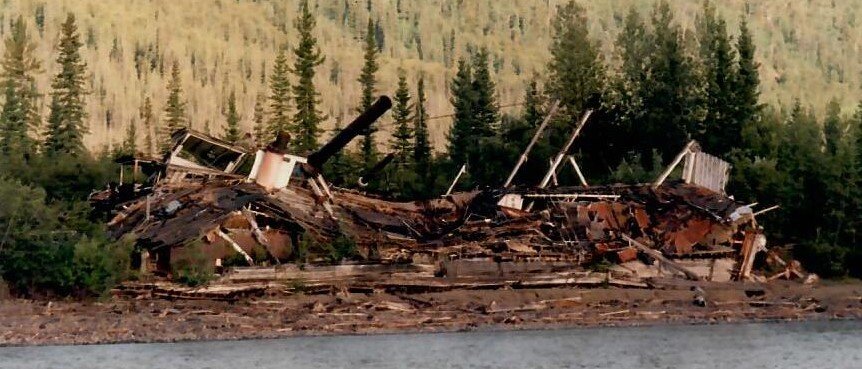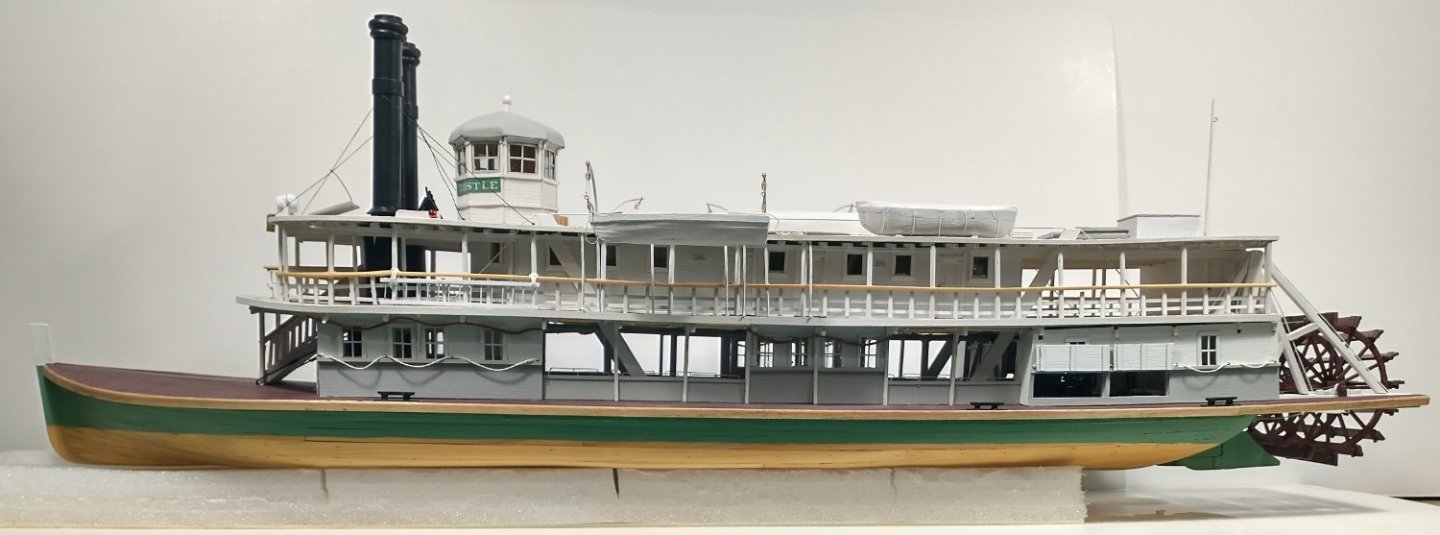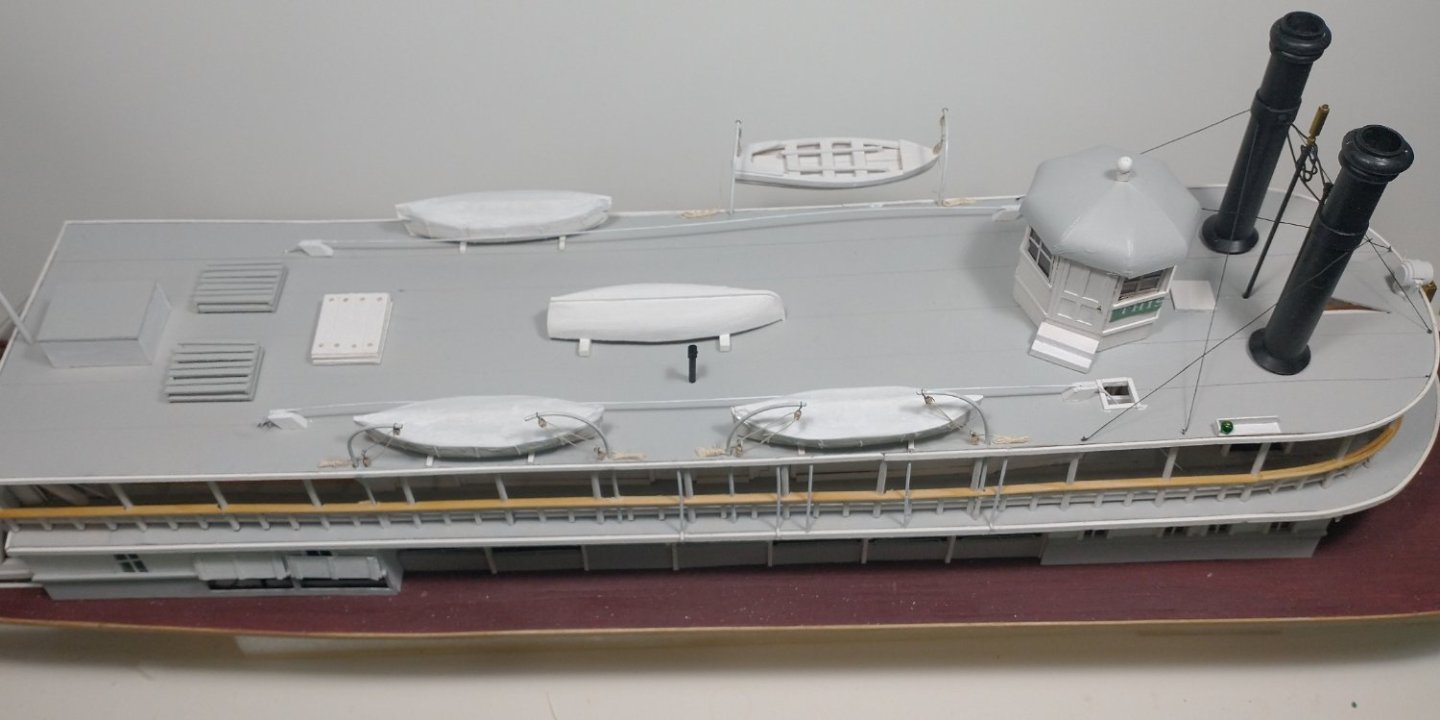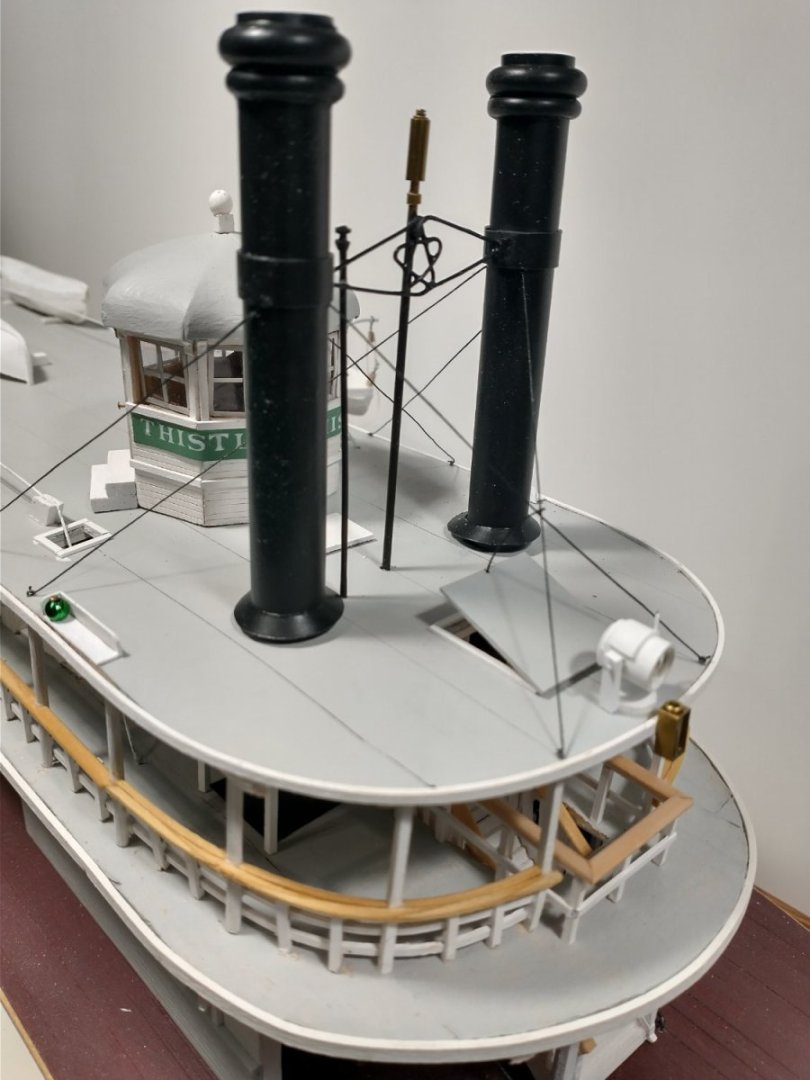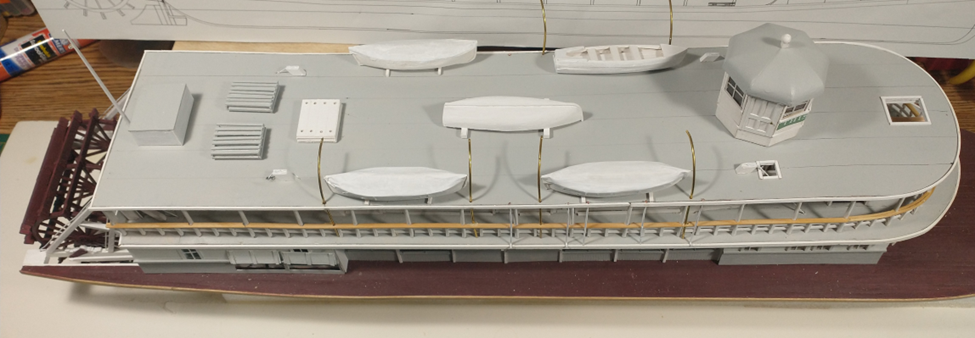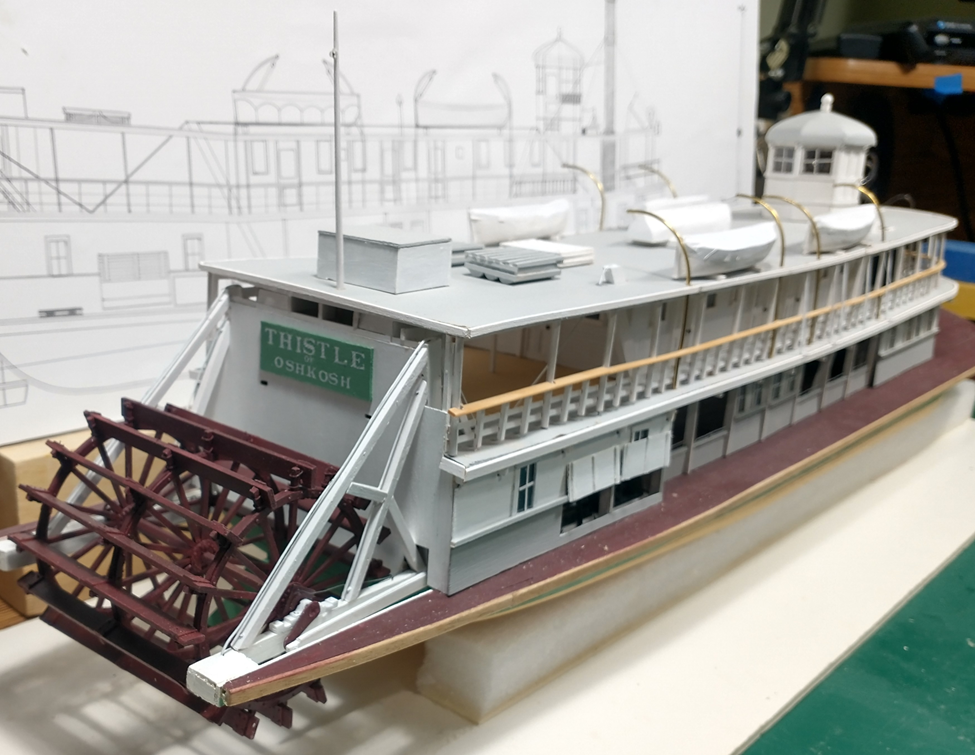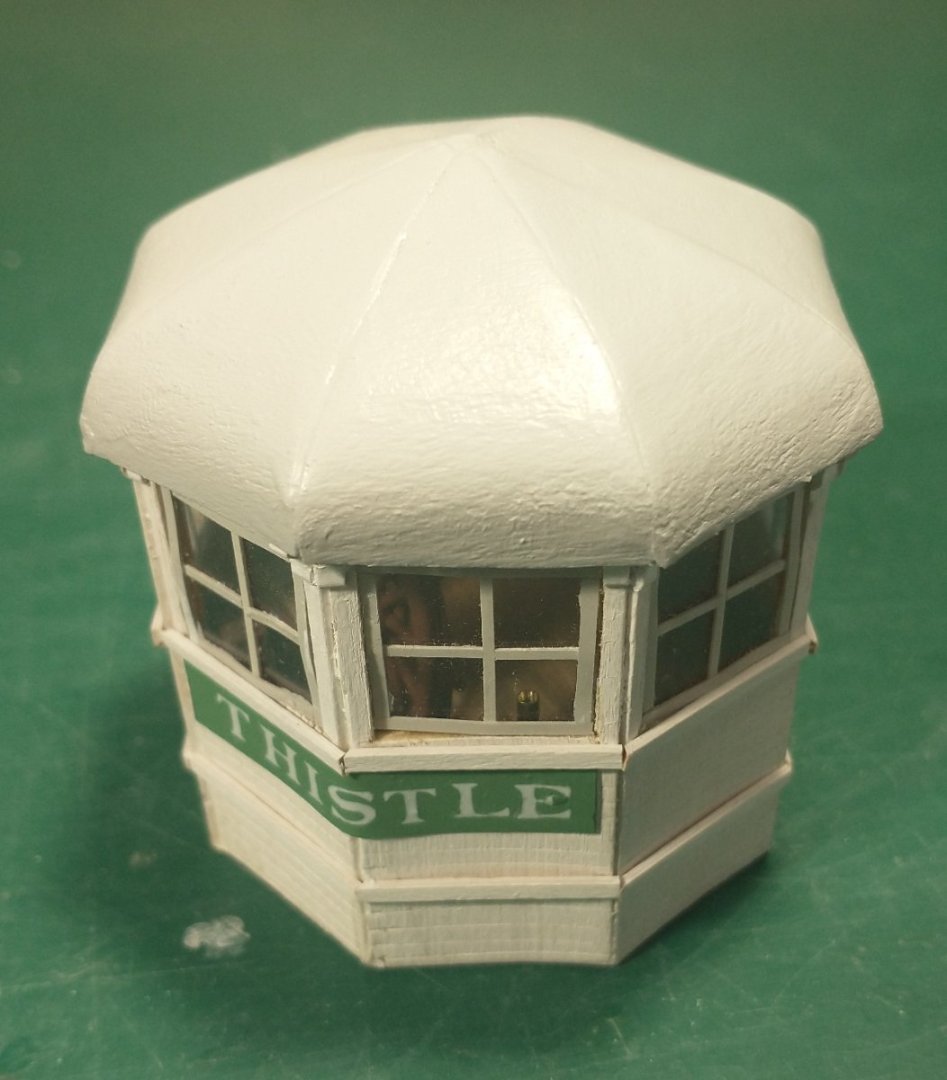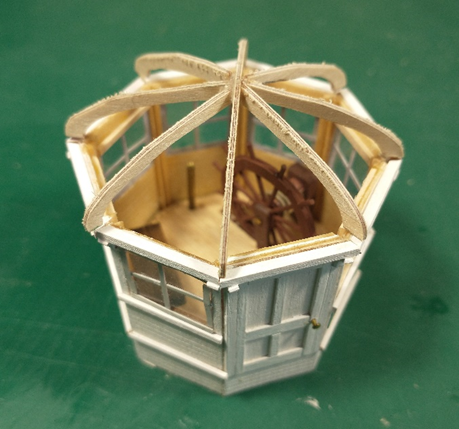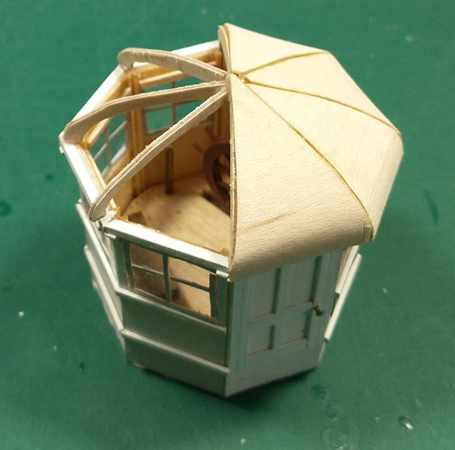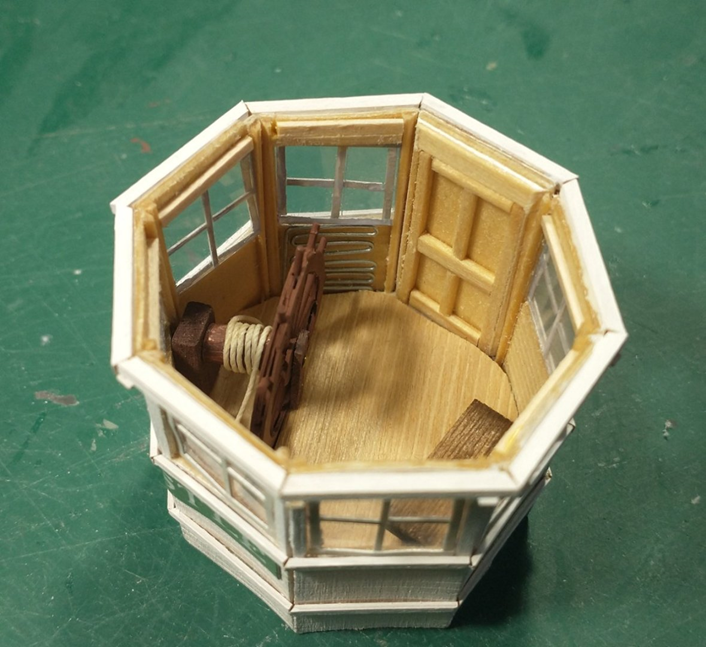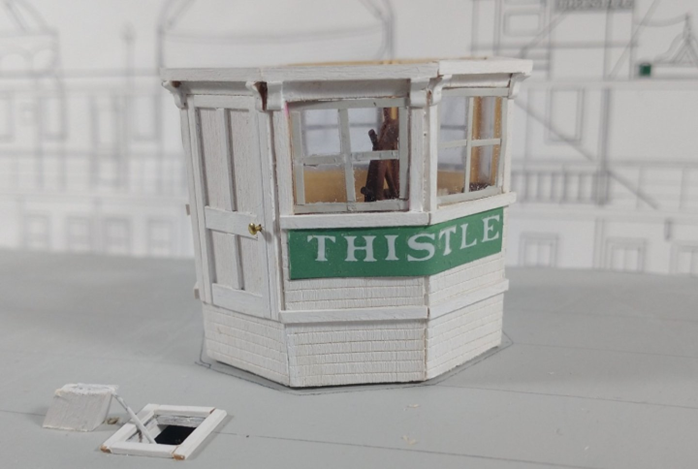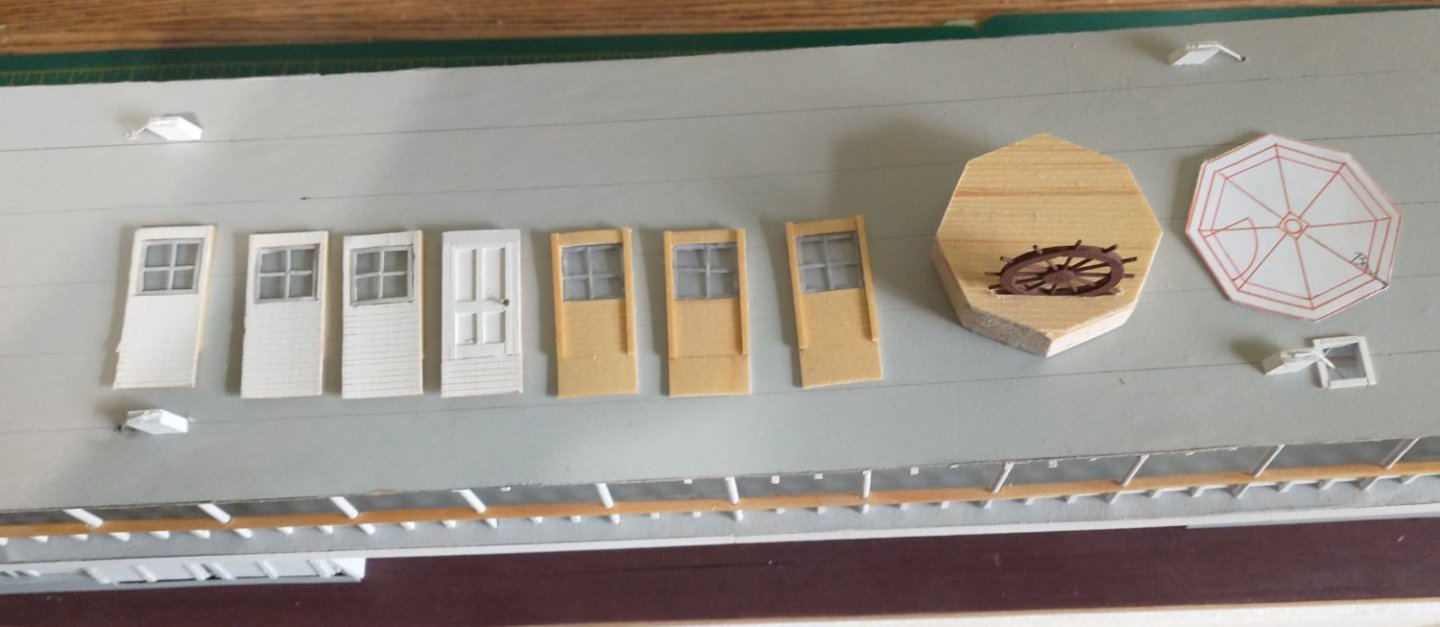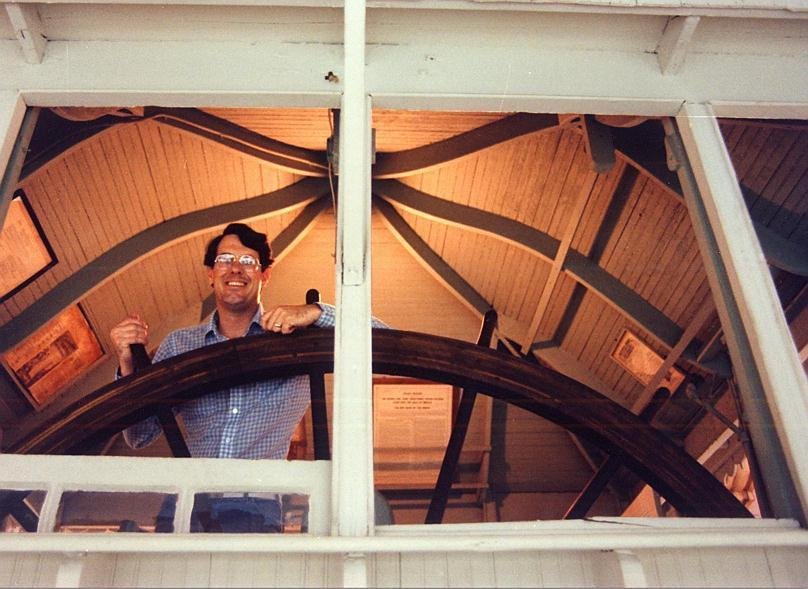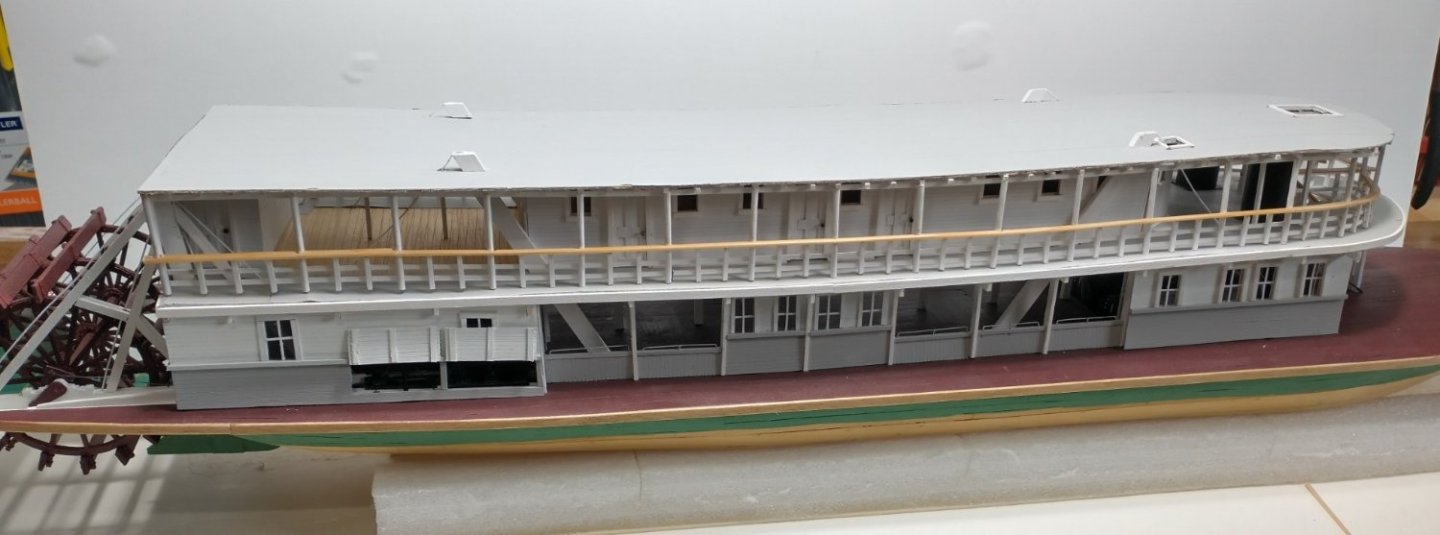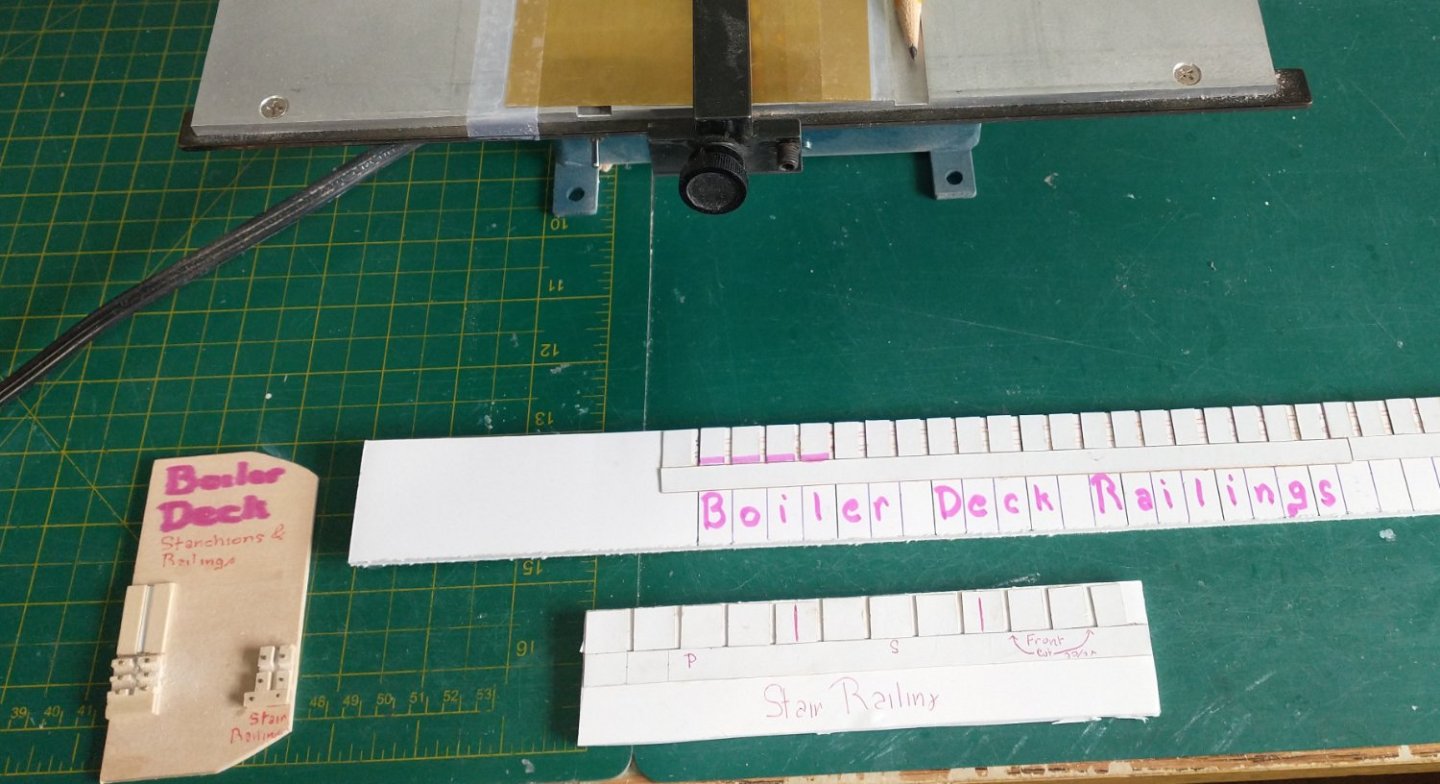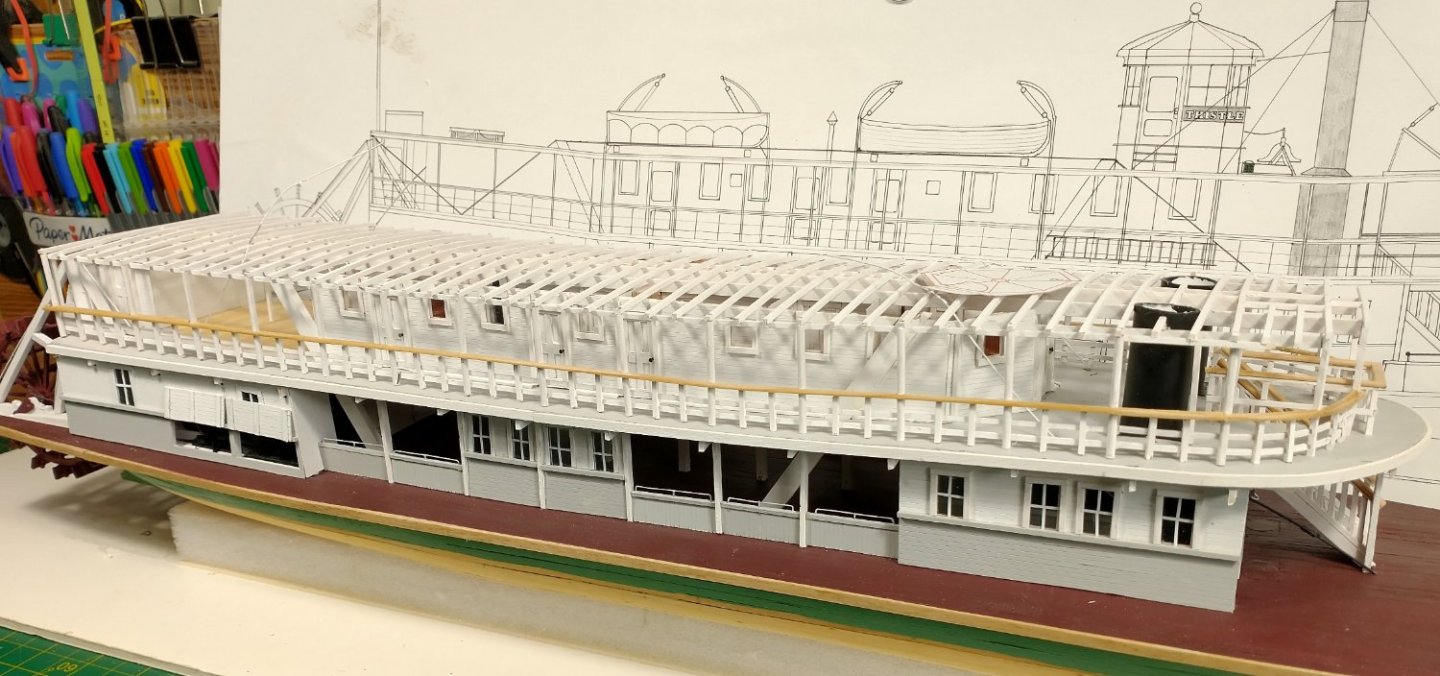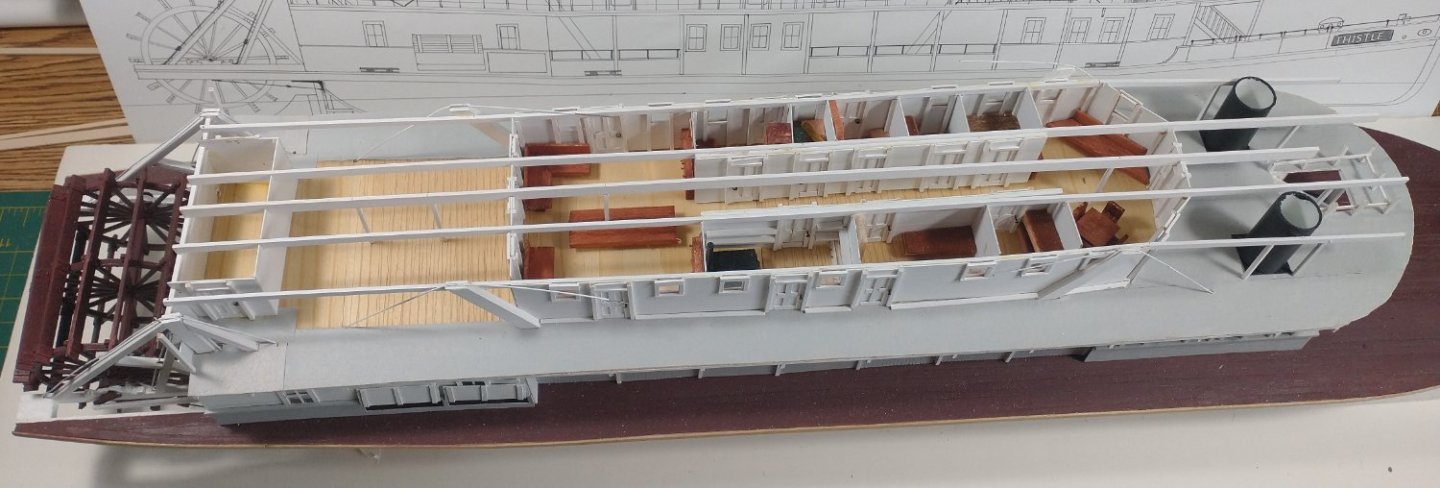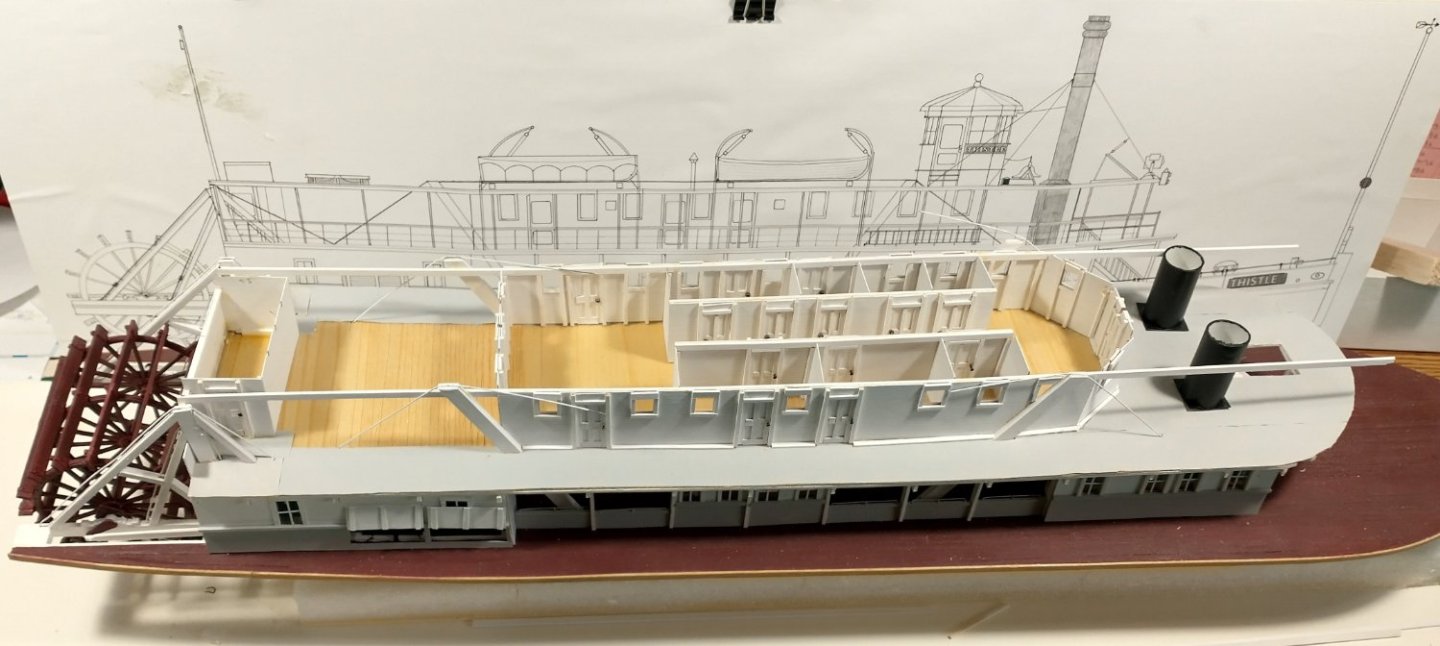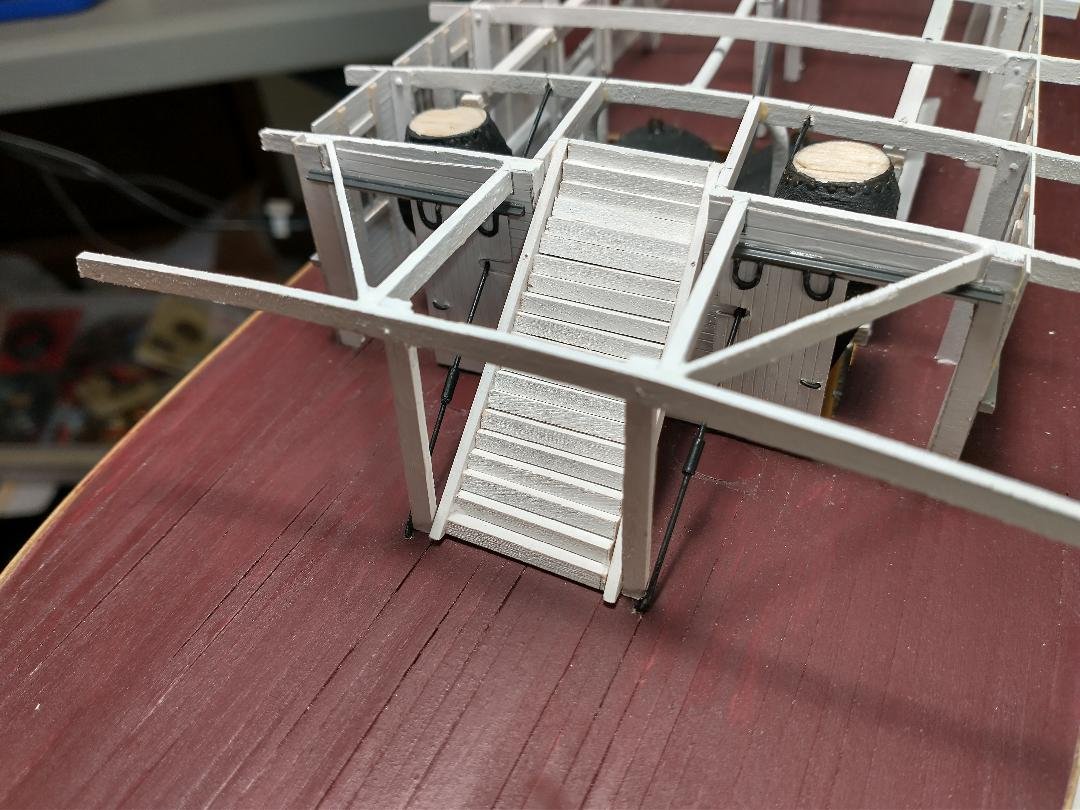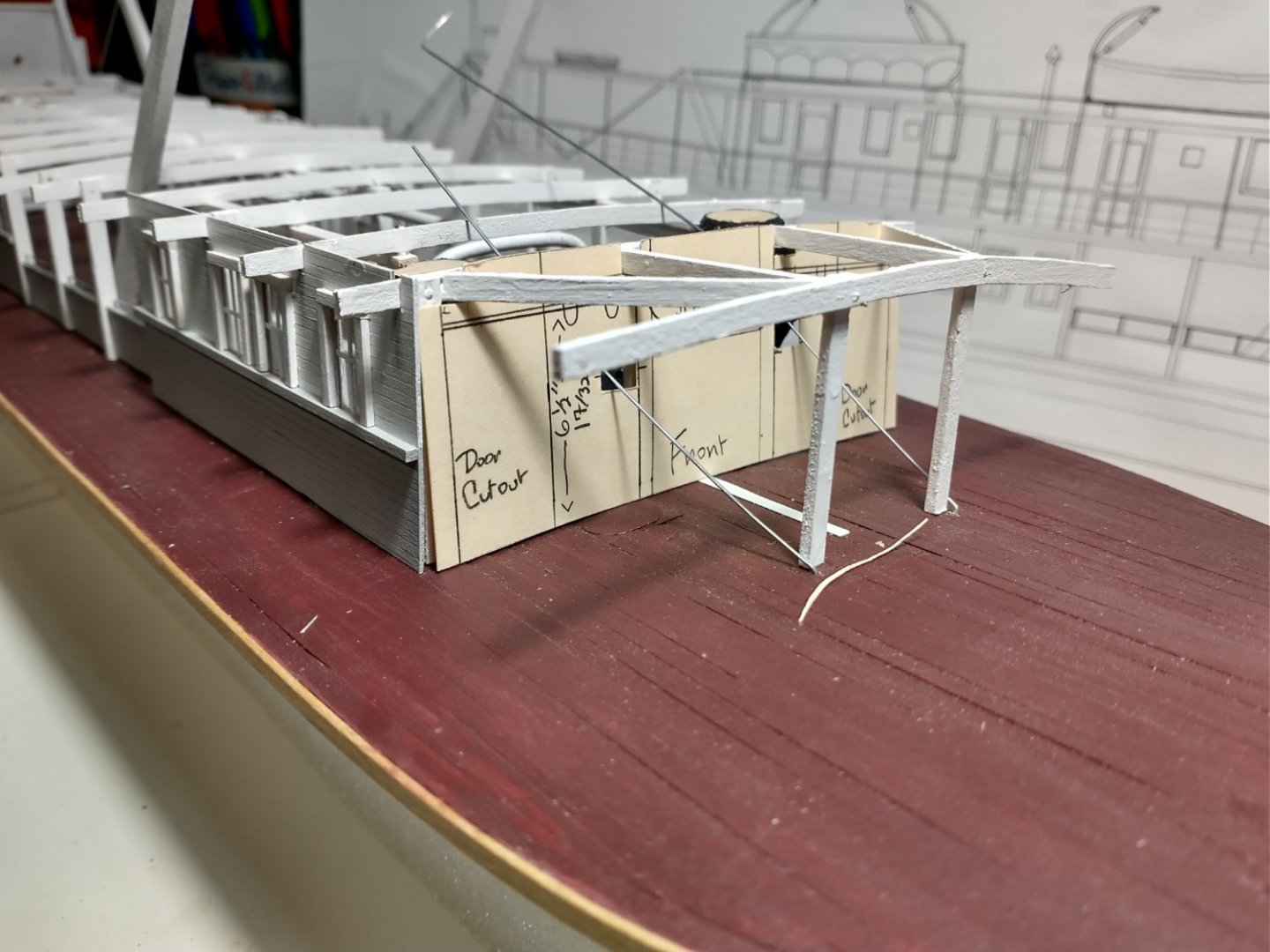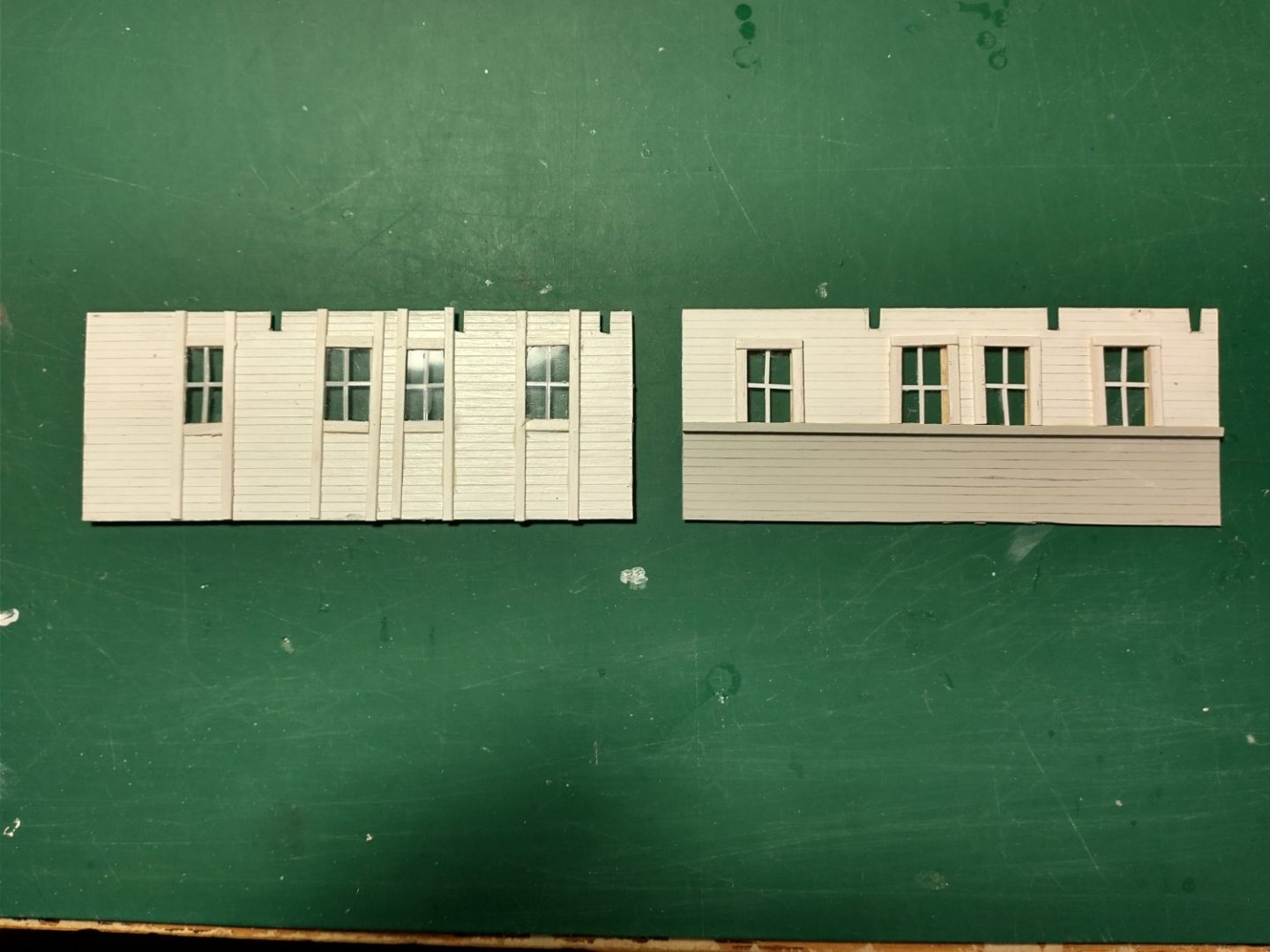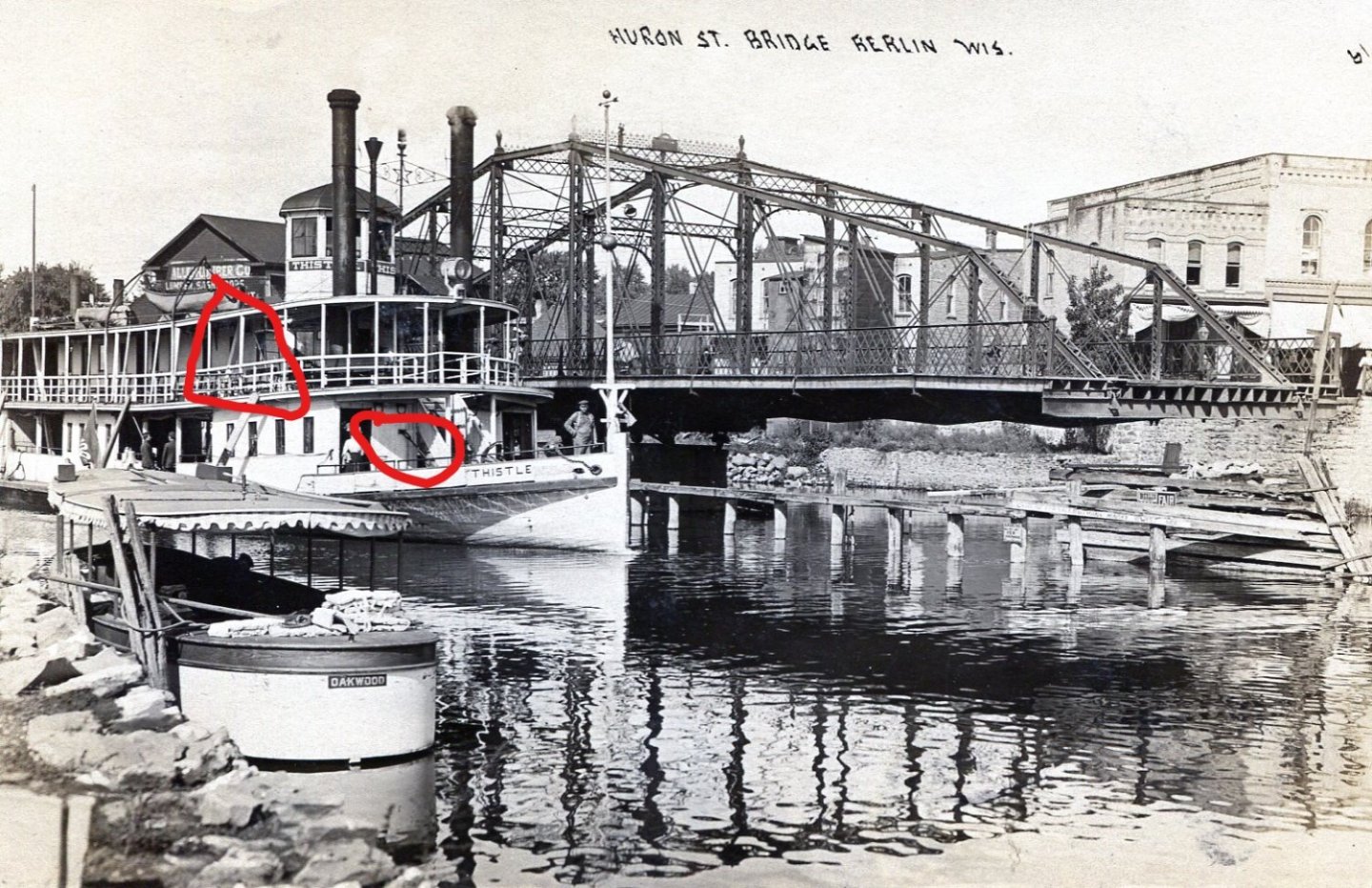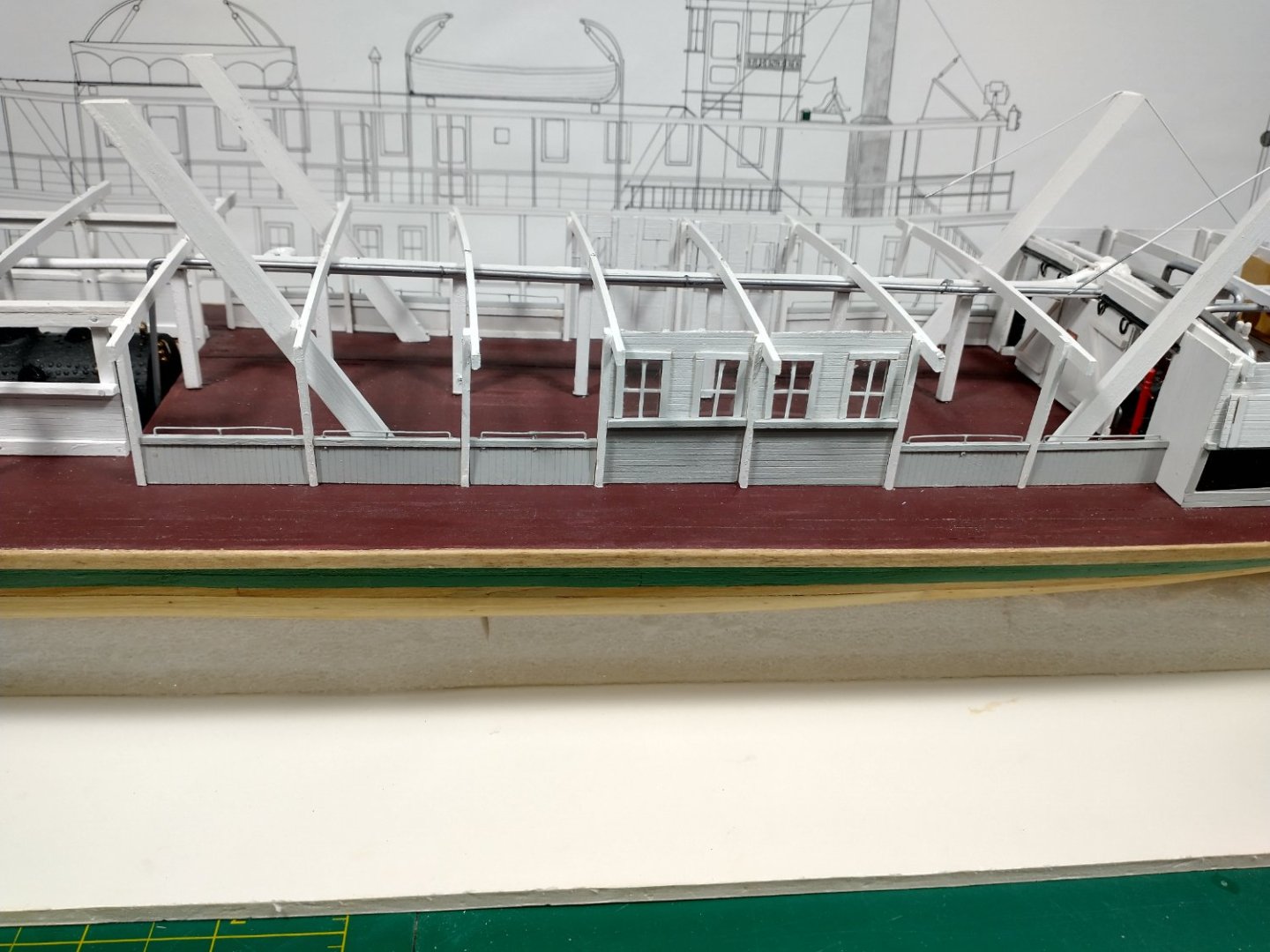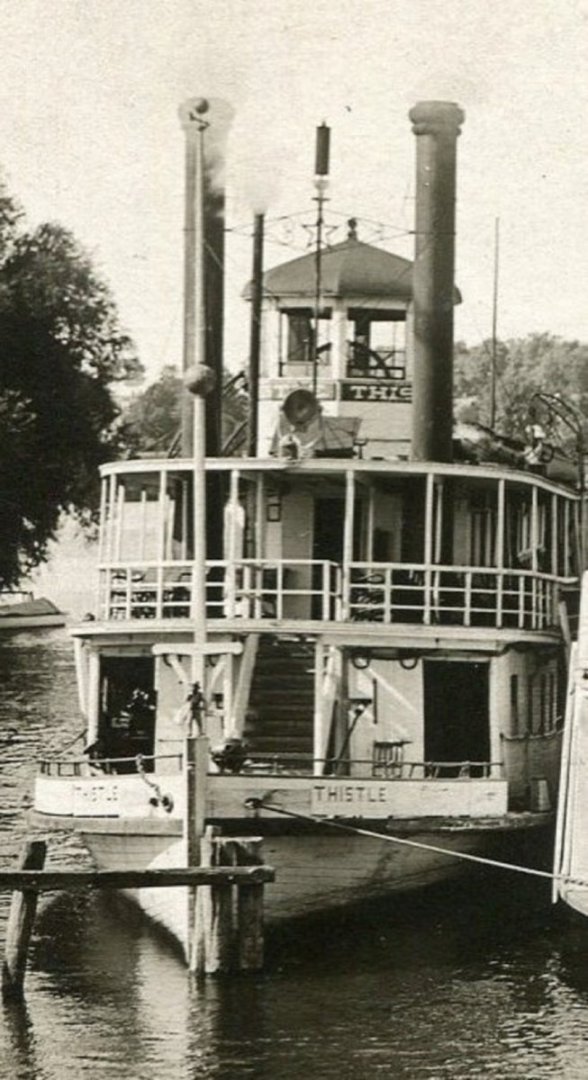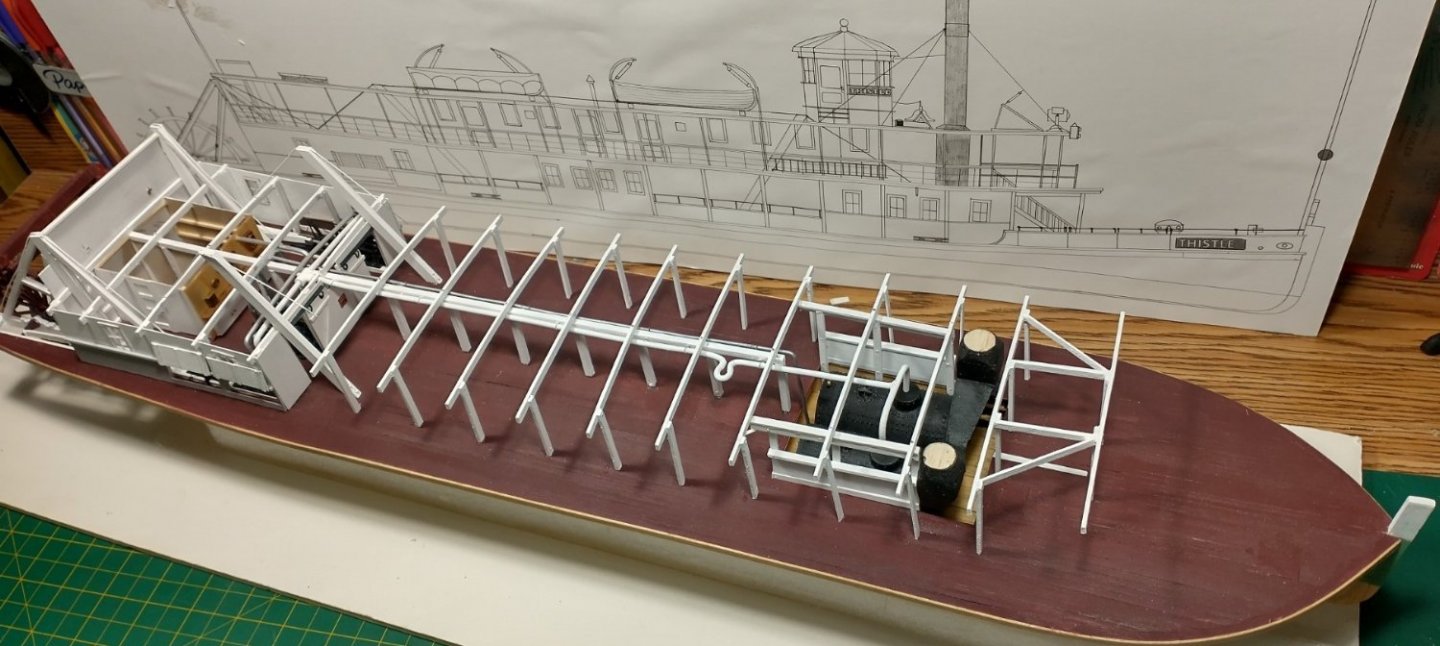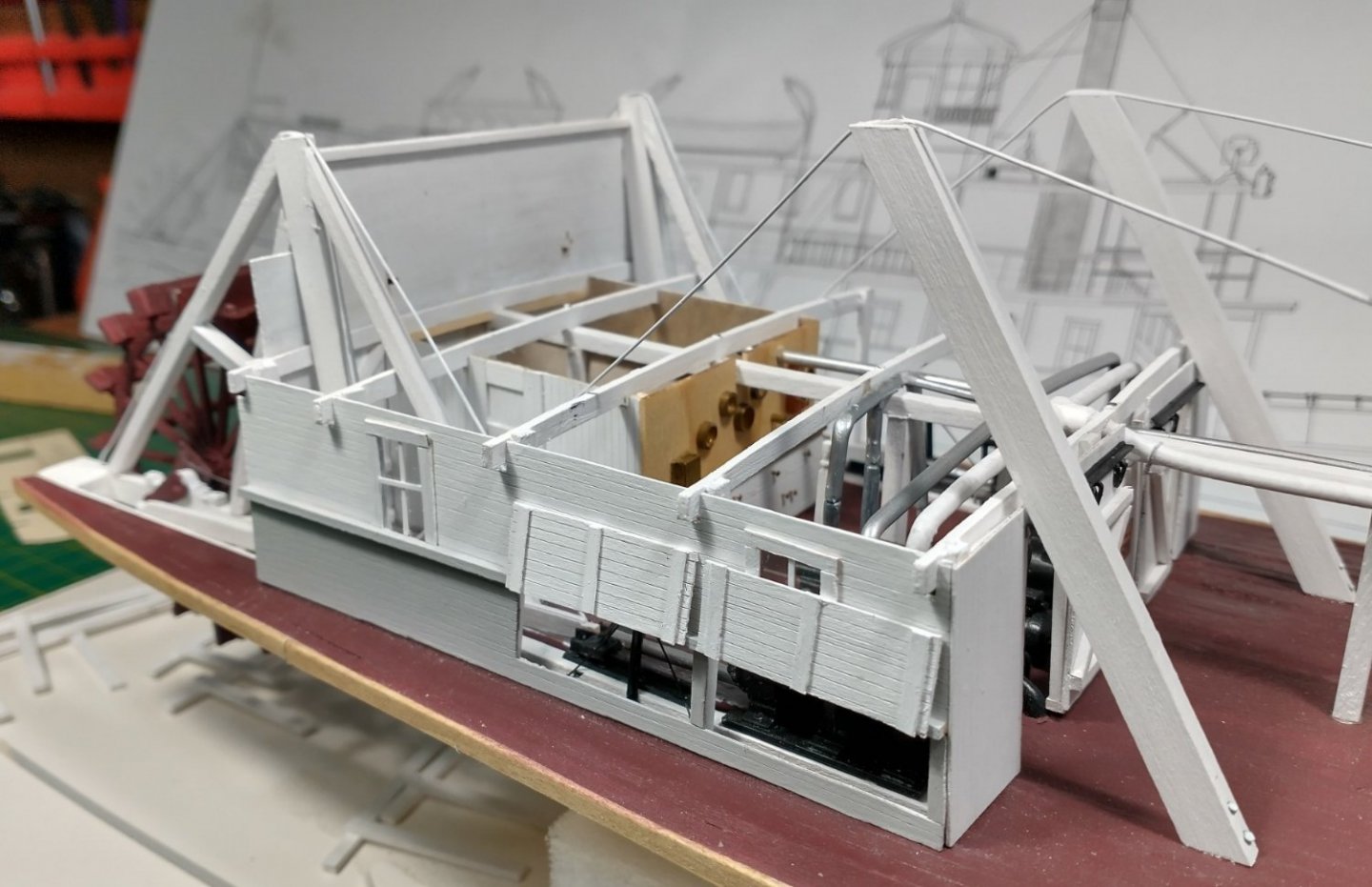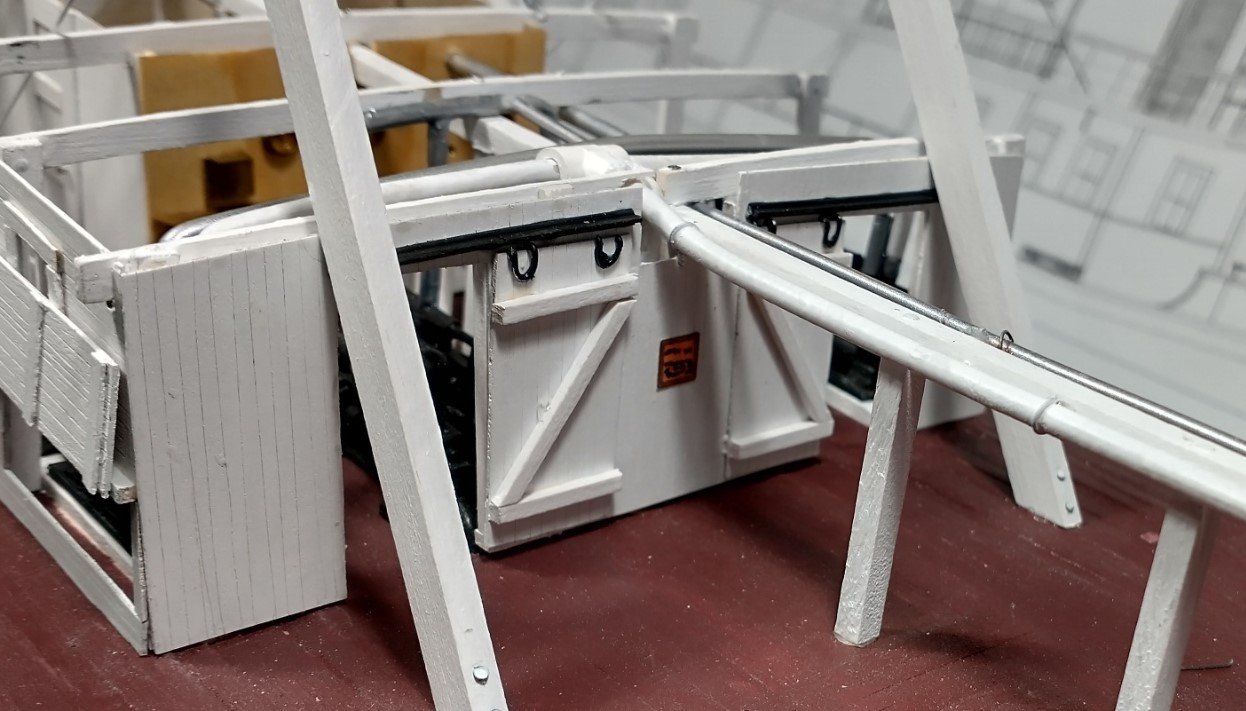-
Posts
143 -
Joined
-
Last visited
Content Type
Profiles
Forums
Gallery
Events
Everything posted by LJP
-
I am finally getting close to the end of my Thistle build after two years. The hurricane deck was finished with the addition of fire buckets and the bell. The boiler deck had "Official Notices" in 2 height font attached. A ladder to the pilothouse was added along with the two ladders attached to the railings. The latter were the federal fire requirements after the General Slocum disaster. The main deck had the canvas coverings attached above the bulwarks, although they are hardly noticeable. Firehoses were added to the underside of the boiler deck. The firehoses were located under the hurricane deck in the early years. The change may have also been a requirement due to Slocum. Safety ropes were affixed to the boiler and engine superstructures. Lastly, kevels (a/k/a cleats) were attached to the main deck. So what is left is on the main deck at the bow. A capstan, anchor, bulwarks and jackstaff are still needed to finish the project. But again, during summer, modeling takes time. I hope to finish in August - the month Thistle (as the J.H. Crawford) was launched in 1894, and as Thistle was sent to the breakers in 1915. That I started and finished the build and will finish it in August is pure coincidence.
- 105 replies
-
Cathead & John, thanx for the kind words. I really get little modeling done in summer but I have pretty much finished the hurricane deck except for the bell and lots of paint touch-up. After I complete that it on to final touches on the boiler deck: ladders, hoses, placards &c. Two different perspectives, the latter photo is wonky due to the photo's perspective. The stacks were a bit of a challenge. The stacks themselves are 1/2" K&S aluminum tube with the tops of half round Evergreen or Plastruct. The spreader is shaped copper wire with the whistle and vent brass tubing. There will still need to lots of things done on the main deck but Thistle looks like a sternwheeler and an end is getting closer after nearly two years.
- 105 replies
-
boboandlucy, Thanks for your kind comments on the pilothouse. It was a bit of a challenge to make. An updated hurricane deck. I have added the verge pole, water tank, rafts, safety planks, and five boats ,along with the unfinished davits. All are just placed and not affixed to the deck. I have lots of detail work that still needs to be done here. I did add the three drains from the hurricane to boiler deck, along with the two additional hurricane deck supports for the forward life boat. I am thinking about adding the stacks and then coming back to do the detail work. It is starting to look like a sternwheeler but still has a long way to go. Once the hurricane deck is complete, I still need to do all of the bulwarks, capstan and jackstaff at the bow. And tons of little odds and ends that I have yet to start.
- 105 replies
-
The pilothouse roof is on. For the roof supports I used 1/32 birch plywood. This is much stronger than the 1/32 basswood that I had used for the superstructure panels. The roof panels are 3/84 maple veneer. I soaked then in water so I could bend them at the base of the roof. The panels were standard with a little trimming to fit. The finished product after sanding, sealing and painting. I still need to add the filial on top and make the stirs to the pilothouse For the next project, I will start at the stern of the deck and build all of the attachments; verge pole, water tank, rafts and safety planks, and five boats. Some of this will go quickly but the boats may take some time.
- 105 replies
-
I assembled the pilothouse. Again, took longer and several attempts. Still not really satisfied with it but I will now finally start the roof. I still need stairs to the door. The interior photo shows the wheel, part of the lazy bench and the radiator. Speaking tube is hidden in this photo. I am not certain if there was a compass. There were references to Thistle missing its landing in the dark or in fog so I wonder if there was one or if it was not used.
- 105 replies
-
I have built the panels and the base along with the wheel. The wheel was "about six feet across" and Bates said 2 spokes per foot diameter so I needed 12 spokes. This looks about right for the number of spokes per photos. Photos also had the wheel about mid-height of the pilothouse windows so I needed to cut into the base to shorten the height of the wheel. Several other photos had the pilot standing outside the pilothouse on the port side while steering. The wheel is close enough to the windows to allow this. I intend to affix the panels to the base, add in all of the pilothouse parts and pieces (wheel, lazy bench, radiator, speaking tube &c.) and then start on the roof. I expect the roof will take a few attempts before I get it right. Some photos did show a visor but I have found none with breast board. I will probably include neither as the pilothouse windows will be closed.
- 105 replies
-
G'Day! I am back from over five weeks with Tassies, Aussies and Kiwis. [a/k/a my family duties] The countries are wonderful but it is really the people that are the most wonderful. But care must be taken at the pubs with the locals and the consumption of "stubbies". It may be another week or so before I can dig out and get back to modeling.
- 105 replies
-
I have started on the pilothouse. I will break this project into two parts, the roof, and everything else. This is how far I have gotten on the "everything else". No photos yet because... I started with an eight-sided balsa and basswood floor base that will provide support to the panels. The floor and base need a cutout for the described "about six feet across" wheel which is about 1/3 below floor level. The actual Thistle wheel may still be at the Oshkosh Yacht Club, but I have not followed up on this lead yet. I had built the eight panels, seven with windows and a single door panel. It will be interesting to properly attach those into a hex layout even with the aforementioned base. Unfortunately, I am not satisfied with the initial results, especially the windows. Back to the drawing board and a re-do. The unstarted interior will be fairly simple: wheel, lazy bench, compass, speaking tubes, pulls for the bell & whistle, and a radiator. There was not a stack for a pilothouse stove so I will go with a radiator. Period radiators appear to be pipes run back and forth as on Yukon steamboats rather than the traditional 1920s free-standing radiator noted on Moyie. The interior will be boiled linseed oil instead of the sea green paint espoused by the Moyie preservation. The roof will be a challenge and I will save that for last. There are a few photos that will assist me in the roof process. From Online Steamboat Museum Dave Thomson Collection [Steamboats.com/museum] an excellent photo of the underside of the Golden Eagle pilothouse. Although this is a square pilothouse, it gives a great idea what the underside of the roof a real pilothouse would have looked like. No idea who the "pilot" at the wheel is. Note the legal requirements posted to the ceiling in order to passive-aggressively fulfill federal requirements of required certificates etc. being conspicuously posted. I have extended "family duties" that will prevent me from working on the model for at least the next several weeks. But I will get back to things as soon as I can.
- 105 replies
-
The hurricane deck is now attached. I used Midwest 1/64 birch plywood, scored and painted white on the underside, spray adhesive and tracing paper painted grey on the top. You cannot tell from the photo but the top is lined to simulate the canvas seams. Now I need to build and then add numerous things to the deck: stacks & pipes, a bell, pilothouse, boats, rafts, water tank, verge and numerous other small items. The I can add the hog chains and complete the facing.
- 105 replies
-
Hi Eric! Thanks much. This is what I did to build them. I know there are better methods, but it worked for me. Thistle's railings were much simpler than much of the bric-a-brac on larger steamboats. Photos on my first post show how straightforward it truly was. I used the jig and templates below to build the railings. The jig on the lower left was used to file cutouts for the railings on the 1/16" square stock used for the spindles and stanchions. It also provided the correct height for both the spindles and stanchions. The spindles and stanchions were then inserted into the Boiler Deck & Stair Railings templates. The lower railings were 1/16" square stock cut down on my Jarmac to 1/32 x 1/16 and then inserted into the filed cutouts. Easy. The top rail was 1/16 x 1/8 that had rounded edges and was finished with boiled linseed oil. It fit across the top of the template. Again easy. The rounded section at the bow required bending over templates and hand fitting. Took longer but still came out okay. Again, there are many ways to achieve this but it worked well for me. Thanx again, LJP
- 105 replies
-
I have completed the railings and the transverse carlings. Jigs and templates made this process a whole lot easier. Thistle is actually and finally starting to look like a sternwheeler. My next step will be to add the hurricane deck. The paper cutout on the deck is for the pilothouse. The pilothouse build will really be interesting. The pilothouse roof actually had two different styles. I will use the post-1901 style as shown on the plan in the background as this was the one in use for my time period. The earlier version had a lip at the bottom of the roof. One of my challenges is that as I look at my Thistle photos for the umpteenth time, or as I get new ones off of eBay, &c., new details or changes are noted. The parts and pieces will be "circa" historically accurate but will be an amalgamation of several different photos and years. Part of the challenge is that there is no single photo that shows all of the detail needed to build the model. But I am extremely grateful that there are that many photos, unlike some sternwheelers that have a single or no photo at all.
- 105 replies
-
Well, I got the longitudinal beams and supports in after I did the furniture. I know - you will never be able to see some of the furniture at all and most others will be a restricted view at best. But I know it is there and it continues to be good practice on some out of practice old fingers. Railings are next. I have started on a few jigs for the railings. I will do the railings in sections. I will hold off on the boiler deck ladders (added due to Federal safety regulations after the General Slocum disaster) until further along when I start doing all of the little odds and ends.
- 105 replies
-
I completed the boiler deck structures. I scored all of the planks horizontally. This is how the Steamboat House at Marble Park in Winneconne was constructed. S S Moyie in Kaslo, B.C. was much different: the outward panel was horizontal, the inboard panel was vertical and the two side panels were diagonal. The diagonal panels were probably much more structurally sound, but the Steamboat House is more region specific. I know no one will probably ever see the interior panels that I put in, but I know that it is there. I know what some of the rooms were: men's and women's saloons fore and aft, galley, and staterooms for captain, cook, and engineer. I used the remaining space for extra staterooms, pursers' office, and freight office. Now I need to build some furniture for the rooms. After that, I can affix the stacks (whatever the oversized metal protection is called) and add the longitudinal beams. The boiler deck will still take some time to complete as the as transverse carlings need to be added, railings and stanchions, stair rails, etc.
- 105 replies
-
Dan, Sorry to be really late to the game here as I recently found your article in the Spring 2022 Journal. Your whaleback is exceptional. The last surviving whaleback, the Meteor, is now a museum ship in the Superior, Wisconsin harbour. I had an opportunity to tour it several years ago. It had been modified over the years but the basic form is still apparent. Between the low freeboard and the crews quarters, it must have been a horrible boat for the crew to ship out in. Again, great model that does whalebacks proud.
- 33 replies
-
- James B Colgate
- whaleback
-
(and 2 more)
Tagged with:
-
I completed the boiler deck. I used 1/64 birch plywood. Both top and bottom were scored to simulate planking. The underside is white, the top is linseed oil with a light gray painted tissue to simulate "canvas, painted and sanded". Based upon actual other steamboat photos and other models, I used the "canvas" in areas that were not covered and therefore subject to the elements. I was not certain about the covered and open area at the stern that was used as both the dining room and general passenger area. I had mentioned previously I am really not certain if this is historically accurate. I will now start on the boiler deck superstructures. The foreward part of the cabin (12 by 15) was the men's "smoker", which had a hall that connected it to the women's saloon toward the stern. The original women's saloon was also 12 by 15, but later photos indicate that it had been expanded, probably when the addition 14 feet were added to the hull. Either side of the hall included staterooms, galley and captain's quarters. The toilet at the stern may have included a wash area between the men's and women's toilets, beneath the water tank on the hurricane deck. Toilet dimensions were estimated using photo measurements. Amazingly, the last Ryan built sternwheeler, the Leander Choate (2nd) [1908 - 1922] listed the actual measurements of the toilets as 6 by 6. Strange what was or was not listed in old accounts.
- 105 replies
-
I have completed the stringers and added the steering chains. I used the layout from a Paul L. Neenah Historical Society photo as a basis. For some reason I cannot load that photo for inclusion here. The boiler deck stringers ran longitudinal (bow to stern) with the deck boards transverse (port to starboard). The two wires on the bow are the hog chains which I will add after the boiler deck is added. Now I can add the boiler deck. I need to figure out when to add the deck versus dry fitting the deck and/or building the staterooms first and then affixing the deck.
- 105 replies
-
Hi OrganizedImages! How incredible that you were able to find an article about the Thistle in your Grandmother's Autobiography! What she was referring to were the Merchant Excursions. The Excursions were subsidized by the Oshkosh merchants, hence the low 10 cents versus the normal 50 cents. The intent was to increase the Oshkosh business by poaching customers from outlying areas. Many of the other Lake Winnebago towns were included in the Excursions but obviously on different days. Many references were made of the Thistle being loaded with goods for the trip home - even the hurricane deck was used for light goods. Interestingly, some merchants of outlying areas used this as a means to supply their own stores. Other merchants, as in Fond du Lac, were not pleased and responded with their own boat and excursions - but that did not last. Still other merchants organized protests against the Oshkosh excursions - again to no avail. The Excursions ended about 1915. This was one of the reasons for scrapping the Thistle. Buying habits had changed (think Sears catalog) and the advent of interurban transportation meant one hour on a train instead of four on a boat. And the boating season, weather permitting, was April to November. This was also the advent of autos. The Sunday excursions that she mentioned were slightly different. Normal stops were Clifton, Stockbridge, Calumet Harbour & Brotherton. These were mainly for recreation, and visiting, as she mentioned. There were numerous large and small craft that conducted these. Another craft that she may have used was the B. F. Carter. I have lots more info but will stop instead of filling up these pages. Thanks Again! LJP
- 105 replies
-
Thanks Cathead! My return took MUCH longer than expected as "life got in the way" but things are back to normal. I can finally dedicate time to the model. LJP
- 105 replies
-
It has really been a while since I have worked on the model but summer is long over and the New Year approaches. I completed the front of the engine room. This means that I can now get started on the Boiler a/k/a Saloon a/k/a Promenade deck. I need to lay some stringers then I can get started on the planks. While maybe a not quick process I will be able to stay at this on a more dedicated basis.
- 105 replies
-
I have been gone for several weeks but am back for a few days before I am busy again. Here is my mock-up for the boiler room front panel. I will get started on the real panel in a few weeks. The chains appear to attach to a cross brace and do angle toward the keel, as Cathead had mentioned. I will attach the other boiler room panels first before I start on this panel. Below is what those side panels look like. The colour is not true, they are actually white and gray. The windows are made of cheap plastic packaging material from my junk pile and then scored for the grids. The grids are .25 x .75 mm Evergreen strips. They are secured to the clear plastic with MEK. I will not be able to work on the model for the next month or more. Wisconsin summer is too short and very busy.
- 105 replies
-
Hi Cathead, I agree with you that it is probably attached to a structural post or cross bar. I have several other photos and the brace does angle inward - probably connects to the keel. I am creating a cardboard version of the boiler room door panel and will then take a piece of wire to try and determine where the brace could have started from, both horizontally and vertically. This brace may have been added when the J H Crawford was lengthened 14 feet and renamed Thistle. The original single boiler was replaced by two boilers at that time. Those boilers were also replaced when the single stair replaced the old-style double stair and all the other modifications were made. Photos of Thistle with the double stair obscure these braces - if in fact they were present at that time. I will see where the mock-up takes me but I will never be 100% certain.
- 105 replies
-
Hi Roger, Glad you like the expansion loop on the main steam line. I used insulated electrical wire to simulate the steam line so it was not difficult to replicate. Hi Cathead, thanks for your input. I hope this photo of one of my postcards helps. The red circle in the upper left is the normal hull bracing. I agree, it passes through the main deck towards the front of the boiler room. The bracing that I am confused about is in the red circle on the lower right. The brace passes through a cutout on the boiler room doors and passes through the main deck close to where the stairs start. This seems to be much heavier than the hog chains - almost like a threaded iron rod. It is hard to see in either photo, but there is a turnbuckle just in front of the door. Pure conjecture on my part, but it seems to be connected to something in front of the funnels & breeching. Thanks, LJP
- 105 replies
-
I have added the bulwarks and the mid-deck superstructure. Thistle's bulwark planking was run vertically while the superstructures were run horizontally. The mid-deck structure was an oddity that I have only found on Thistle but I am sure there were others that had them. Since it was open, I suspect it was to provide some shelter from the weather, but the bulwarks had canvas coverings that were dropped down when needed. I will now move on to the boiler enclosure. Again, since this is summer, I am less than dedicated to working on the model. But I am looking forward to making the main stairway. The hog chains that passed through the boiler room doors are a bit of a mystery to me. They are not the prominent hull bracing but seem to be some sort of boiler bracing. You can see where they went through the deck at the bow, but if they had braces to support them like the other hog chains or something else, I have no idea. Bates had something in his Cyclopedium on hog chains and braces, but nothing quite like this. D. C. Mitchell in his book showed similar chains on his drawings but they really went nowhere. This is what they looked like. If anyone has any ideas as to how this was laid out, I would appreciate it. Also note the LeFevre standing figure on the stempost. Another Thistle oddity.
- 105 replies
-
I have really gotten very little done over the past few weeks. During our summer up here I am normally very busy and spend little time modeling. That said, this is the most recent photo. I will now finally begin on the bulwarks and main deck superstructures.
- 105 replies
-
Cathead & John, thanx for the kind words! Bob and Brian, welcome aboard - I hope you enjoy the build! I finally got the stern hog chain braces and chains installed. I started the engine room superstructure and did take some "poetic license" here. I left both ventilators open so the engines can be viewed instead of where the engine ventilator was often closed. On the sliding doors, I had the Z supports on the outside to make things more interesting. Plain panels just seemed too boring. I have also added the main steam line and a return line. These included the connections to/from the engines and other machinery. I quickly discovered that the actual photos of crowded and confusing engine rooms should have warned me for what the model would be like. Placement of items in an even typical engine room is incredibly complex - even where a simplified layout like mine is used. Should I ever decide to do another steamboat, much more planning is needed here to properly place all of the machinery and lines. I will now start working toward the bow. I will place the stationaries and carlines and begin adding Thistle's unusual bulwarks.
- 105 replies
About us
Modelshipworld - Advancing Ship Modeling through Research
SSL Secured
Your security is important for us so this Website is SSL-Secured
NRG Mailing Address
Nautical Research Guild
237 South Lincoln Street
Westmont IL, 60559-1917
Model Ship World ® and the MSW logo are Registered Trademarks, and belong to the Nautical Research Guild (United States Patent and Trademark Office: No. 6,929,264 & No. 6,929,274, registered Dec. 20, 2022)
Helpful Links
About the NRG
If you enjoy building ship models that are historically accurate as well as beautiful, then The Nautical Research Guild (NRG) is just right for you.
The Guild is a non-profit educational organization whose mission is to “Advance Ship Modeling Through Research”. We provide support to our members in their efforts to raise the quality of their model ships.
The Nautical Research Guild has published our world-renowned quarterly magazine, The Nautical Research Journal, since 1955. The pages of the Journal are full of articles by accomplished ship modelers who show you how they create those exquisite details on their models, and by maritime historians who show you the correct details to build. The Journal is available in both print and digital editions. Go to the NRG web site (www.thenrg.org) to download a complimentary digital copy of the Journal. The NRG also publishes plan sets, books and compilations of back issues of the Journal and the former Ships in Scale and Model Ship Builder magazines.

